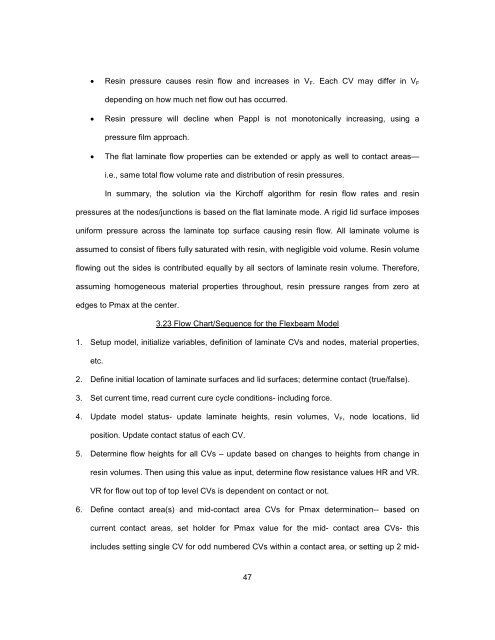TOOLED THICK COMPOSITES by ARVEN H. SAUNDERS III ...
TOOLED THICK COMPOSITES by ARVEN H. SAUNDERS III ...
TOOLED THICK COMPOSITES by ARVEN H. SAUNDERS III ...
Create successful ePaper yourself
Turn your PDF publications into a flip-book with our unique Google optimized e-Paper software.
• Resin pressure causes resin flow and increases in VF. Each CV may differ in VF<br />
depending on how much net flow out has occurred.<br />
• Resin pressure will decline when Pappl is not monotonically increasing, using a<br />
pressure film approach.<br />
• The flat laminate flow properties can be extended or apply as well to contact areas—<br />
i.e., same total flow volume rate and distribution of resin pressures.<br />
In summary, the solution via the Kirchoff algorithm for resin flow rates and resin<br />
pressures at the nodes/junctions is based on the flat laminate mode. A rigid lid surface imposes<br />
uniform pressure across the laminate top surface causing resin flow. All laminate volume is<br />
assumed to consist of fibers fully saturated with resin, with negligible void volume. Resin volume<br />
flowing out the sides is contributed equally <strong>by</strong> all sectors of laminate resin volume. Therefore,<br />
assuming homogeneous material properties throughout, resin pressure ranges from zero at<br />
edges to Pmax at the center.<br />
3.23 Flow Chart/Sequence for the Flexbeam Model<br />
1. Setup model, initialize variables, definition of laminate CVs and nodes, material properties,<br />
etc.<br />
2. Define initial location of laminate surfaces and lid surfaces; determine contact (true/false).<br />
3. Set current time, read current cure cycle conditions- including force.<br />
4. Update model status- update laminate heights, resin volumes, VF, node locations, lid<br />
position. Update contact status of each CV.<br />
5. Determine flow heights for all CVs – update based on changes to heights from change in<br />
resin volumes. Then using this value as input, determine flow resistance values HR and VR.<br />
VR for flow out top of top level CVs is dependent on contact or not.<br />
6. Define contact area(s) and mid-contact area CVs for Pmax determination-- based on<br />
current contact areas, set holder for Pmax value for the mid- contact area CVs- this<br />
includes setting single CV for odd numbered CVs within a contact area, or setting up 2 mid-<br />
47
















